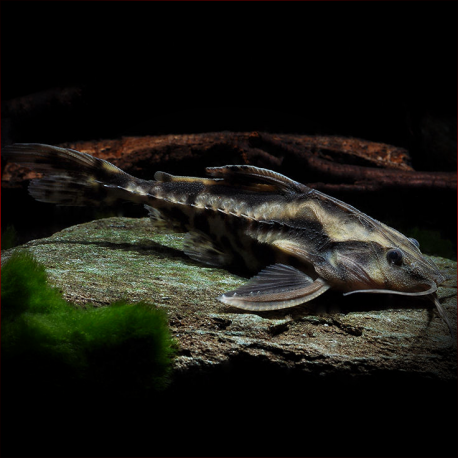More info
Datasheet
| Minimum Tank Size | 3500 litres / 924.60 US gallons |
| Maximum Size | 70.0cm / 27.56inches |
| Temperature | 21.1°C / 69.98°F - 25°C / 77.00°F |
| Hardness | 1-20ºdH |
| pH | 5.5-7.5 |
General Description
The Giant Raphael Catfish, scientifically known as Megalodoras Uranoscopus, is also commonly referred to as the "ripsaw catfish." It belongs to the Doradidae family and can grow up to 70.0cm in size. This species is recognized by its unique infranuchal scute, distinguishing it from other Siluriformes. It is known for its peaceful nature and preference for living in conspecific groups.
Aquarium Setup
When setting up an aquarium for the Giant Raphael Catfish, a sandy substrate with driftwood or a bare bottom tank is recommended. Lighting should not be too bright, and water quality must be diligently maintained. A tank size of at least 3500 liters with a substantial filter system is essential for adult specimens. Water conditions should ideally be a pH of 5.5-7.5, hardness of 1-20 degrees, and a temperature between 21.1-25 degrees Celsius.
Behaviour
This catfish species is known for its peaceful demeanor and can be housed alongside various other species such as characids, cichlids, loricariids, and doradids. It thrives best when kept in groups of four or more, showing improved social behaviors and overall well-being.
Feeding and Diet
As an omnivorous species, the Giant Raphael Catfish primarily feeds on aquatic gastropods and fallen fruits in the wild. In captivity, they readily consume sinking dried foods, fruits, vegetables, mollusks, shellfish, and occasional live earthworms. Regular feeding is crucial, with the need for increased food intake as the catfish grows.
Reproduction & Dimorphism
Reproduction in the Giant Raphael Catfish involves seasonal migrations related to their reproductive cycle. To date, successful captive breeding has not been documented. Adult females typically appear larger and heavier-bodied than males, with distinguishable differences in genital papillae structure.
Habitat and Distribution
These catfish are commonly found in slow-moving or standing waters, including tributaries, creeks, and swamps. The Giant Raphael Catfish is native to the rios Essequibo, Tocantins, and Amazon in countries like Ecuador, Colombia, Peru, Brazil, and Bolivia, with its type locality being Lake Hyanuary near Manaus, Brazil.

